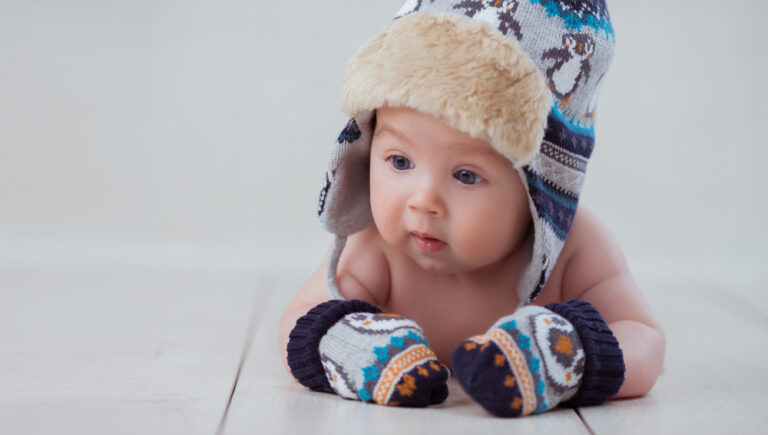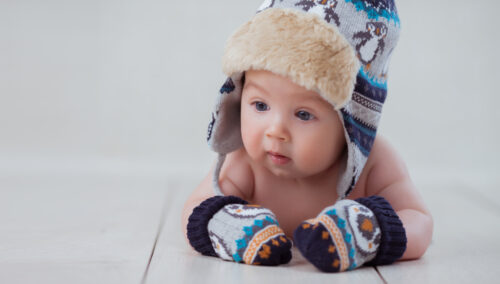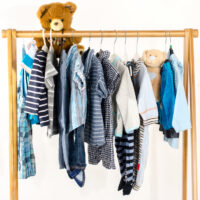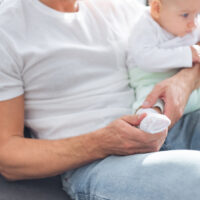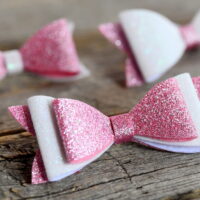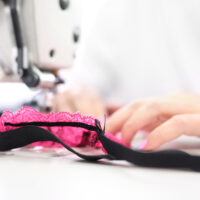Your baby’s ears, hands, and feet are the most susceptible to frostbite in cold winter months. While you likely won’t need to bundle them in gloves unless they are spending time outside, keeping their hands covered is essential for preventing frostbite.
Below, you’ll find some tips on how to keep baby mittens on and guidance as to when you should put baby mittens on your baby.
How to Keep Baby Mittens On
Choose the Right Size
Mittens are usually designed with a one-size-fits-most (OSFM) approach. There may be discrepancies between brand sizes, however, most baby or toddler mittens have a similar size.
What will change the fit is the design of the mitten and the brand. Ideally, the fit of a mitten should be tight around your baby’s wrist and roomy around their fingers. You’ll also want to be sure the mitten isn’t too tight- it shouldn’t be so tight that it cuts off circulation to your baby’s hand.
Choose the Right Mitten Design
There aren’t a lot of parenting hacks for keeping mittens on your baby. Fortunately, there are still several solutions. Look for built-in mittens or mittens designed to better stay on your baby’s hands.
Below, we’ll take a look at all the options so far and the benefits of each.
Snowsuits, Jackets, and Onesies with Built-In Mittens
If you are going to take your baby outdoors, one thing you can look for is snowsuits or baby jackets that have covers on the end of the arms. The hand covers fold down and around your baby’s hand like a mitten. Since they wrap around your baby’s hand and stay attached to the jacket, they’re harder for your baby to pull off.
If you are staying indoors and just want some coverage for scratching, look for long-sleeved baby onesies with attached mitten cuffs. These also work well for fall or spring days outdoors when baby needs a little extra protection from cool breezes.
Velcro and Bungee Cords
If you want to keep mittens on your baby that are not attached to their jacket, you’ll want to look for something with elastic, Velcro, or a bungee cord that wraps around the wrist.
Bungee cords are more common in gloves for toddlers than babies because the hardware is a choking hazard, however, Velcro is fairly common. When fastened around the wrist, it makes the glove smaller than your baby’s hand so it won’t go over it.
Elastic
Elastic can also improve the fit of a glove and help it from being pulled over your baby’s hand. However, after the mittens are washed or pulled on a lot, the elastic stretches more easily than Velcro so it doesn’t work as well.
Long Mittens
The other option is a longer glove. There are a few companies that make mittens that go up to your baby’s forearm or elbow. These are tucked into your baby’s shirt or jacket sleeves and they become difficult to pull off.
When Should My Baby Wear Mittens?
If you are indoors, your baby probably doesn’t need to wear mittens. It is natural for babies’ hands and feet to be cool or even have a blotchy or bluish appearance.
Additionally, it’s best to let your baby go without mittens unless they need them. Mittens stop your baby from exploring the world with their fingers, which is critical for sensory development.
The ideal indoor temperature is 68-72 degrees. You can tell if your baby is warm by placing your hand on their lower back. It should be warm without being too sweaty.
Mittens are best for when your baby is going to be outdoors. They don’t even need them in their car seat if they are going to be in a vehicle.
If you are taking your baby out to play in the snow or on a walk, however, you will want to put them in gloves. One of the designs above is best, especially if your little one is playing in the snow. If they do put their hands directly in the snow (which is okay if you want them to feel it and experience it with bare hands), you should only let them play for a minute and then warm up their hands completely. It’s best to do this at the end of playtime since you’ll want to bring them indoors afterward.
Should My Baby Wear Scratch Mittens?
Another type of mittens for newborns on scratch mittens. Scratch mittens are usually made of thin fabric that creates a barrier between your little one’s sharp nails and their neck, face, and anywhere else they might scratch. Even though scratch mittens are a useful tool and are mostly harmless for short-term use, there are other alternatives and it might not always be safe for your baby to wear them.
Here are some of the pros and cons of scratch mittens.
In addition to stopping your baby from scratching themselves, baby mittens add a layer of warmth. Unfortunately, your baby being too warm at night increases their risk of SIDS. Being too hot makes your baby sleep more deeply, so they’re less likely to wake up if they stop breathing. There’s also a risk of threads coming loose or the mittens coming off, both of which can be a choking hazard.
During the day, scratch mittens also stop your baby from exploring the world around them. Babies’ eyesight isn’t the best early in their life, so they rely on their hands to sense and explore everything going on. This prevents them from getting input that’s important for sensory and motor development.
Even though opinions about scratch mittens are mixed, some pediatricians have spoken out against them. There are also some hospitals that won’t use them on the delivery floor.
If you don’t want to use scratch mittens, the better alternative is trimming your baby’s nails. You can also use a nail buffer or file to be sure the edges are rounded, especially if you’re worried about cutting too close to your baby’s skin. Other parents have suggested trimming your baby’s nails while they sleep, too.
Final Word
Many parents struggle with keeping mittens on their little one. Fortunately, there are several solutions for parents wondering how to keep baby mittens on- Velcro, bungee cords, and even a longer design.
Aside from choosing mittens with these features, be sure the mitten fits properly. You don’t want it so tight that it cuts off circulation, but you do want it tight enough that the mitten won’t fall off.
